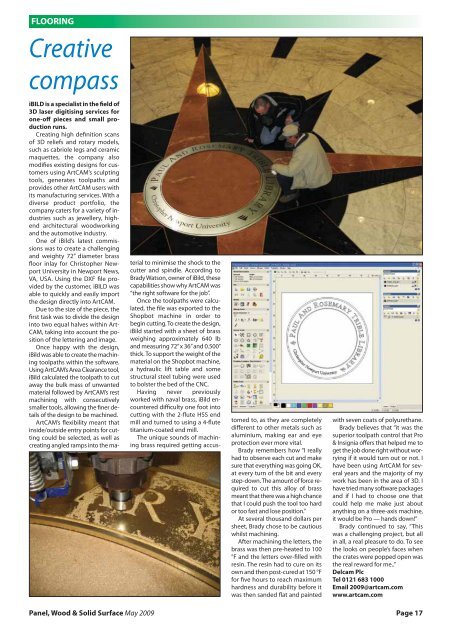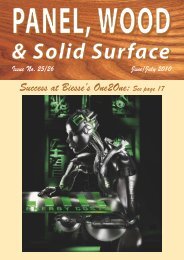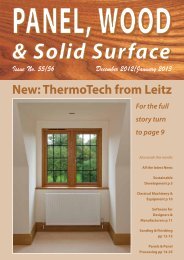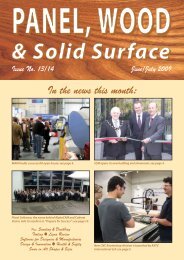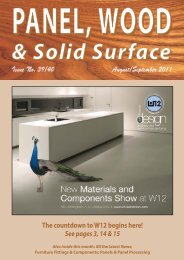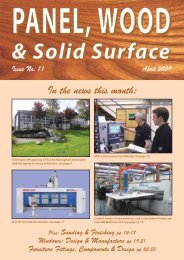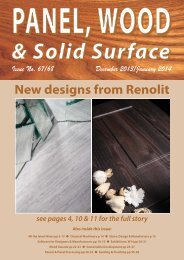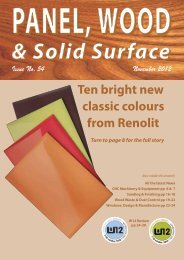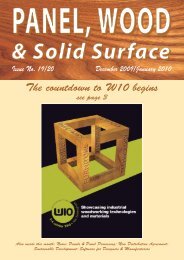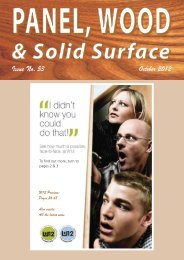May 2009 - Low Resolution - PAWPRINT PUBLISHING
May 2009 - Low Resolution - PAWPRINT PUBLISHING
May 2009 - Low Resolution - PAWPRINT PUBLISHING
Create successful ePaper yourself
Turn your PDF publications into a flip-book with our unique Google optimized e-Paper software.
FLOORING<br />
Creative<br />
compass<br />
iBILD is a specialist in the field of<br />
3D laser digitising services for<br />
one-off pieces and small production<br />
runs.<br />
Creating high definition scans<br />
of 3D reliefs and rotary models,<br />
such as cabriole legs and ceramic<br />
maquettes, the company also<br />
modifies existing designs for customers<br />
using ArtCAM’s sculpting<br />
tools, generates toolpaths and<br />
provides other ArtCAM users with<br />
its manufacturing services. With a<br />
diverse product port folio, the<br />
company caters for a variety of industries<br />
such as jewellery, highend<br />
architectural woodworking<br />
and the automotive industry.<br />
One of iBild’s latest commissions<br />
was to create a challenging<br />
and weighty 72” diameter brass<br />
floor inlay for Christopher Newport<br />
University in Newport News,<br />
VA, USA. Using the DXF file provided<br />
by the customer, iBILD was<br />
able to quickly and easily import<br />
the design directly into ArtCAM.<br />
Due to the size of the piece, the<br />
first task was to divide the design<br />
into two equal halves within Art-<br />
CAM, taking into account the position<br />
of the lettering and image.<br />
Once happy with the design,<br />
iBild was able to create the machining<br />
toolpaths within the software.<br />
Using ArtCAM’s Area Clear ance tool,<br />
iBild calculated the toolpath to cut<br />
away the bulk mass of unwanted<br />
material followed by ArtCAM’s rest<br />
machining with consecutively<br />
smaller tools, allowing the finer details<br />
of the design to be machined.<br />
ArtCAM’s flexibility meant that<br />
inside/outside entry points for cutting<br />
could be selected, as well as<br />
creating angled ramps into the material<br />
to minimise the shock to the<br />
cutter and spindle. According to<br />
Brady Watson, owner of iBild, these<br />
capabilities show why ArtCAM was<br />
“the right software for the job”.<br />
Once the toolpaths were calculated,<br />
the file was exported to the<br />
Shopbot machine in order to<br />
begin cutting. To create the design,<br />
iBild started with a sheet of brass<br />
weighing approximately 640 lb<br />
and measuring 72” x 36” and 0.500”<br />
thick. To support the weight of the<br />
material on the Shopbot machine,<br />
a hydraulic lift table and some<br />
structural steel tubing were used<br />
to bolster the bed of the CNC.<br />
Having never previously<br />
worked with naval brass, iBild encountered<br />
difficulty one foot into<br />
cutting with the 2-flute HSS end<br />
mill and turned to using a 4-flute<br />
titanium-coated end mill.<br />
The unique sounds of machining<br />
brass required getting accustomed<br />
to, as they are completely<br />
different to other metals such as<br />
aluminium, making ear and eye<br />
protection ever more vital.<br />
Brady remembers how “I really<br />
had to observe each cut and make<br />
sure that everything was going OK,<br />
at every turn of the bit and every<br />
step-down. The amount of force required<br />
to cut this alloy of brass<br />
meant that there was a high chance<br />
that I could push the tool too hard<br />
or too fast and lose position.”<br />
At several thousand dollars per<br />
sheet, Brady chose to be cautious<br />
whilst machining.<br />
After machining the letters, the<br />
brass was then pre-heated to 100<br />
°F and the letters over-filled with<br />
resin. The resin had to cure on its<br />
own and then post-cured at 150 °F<br />
for five hours to reach maximum<br />
hardness and durability before it<br />
was then sanded flat and painted<br />
with seven coats of polyurethane.<br />
Brady believes that “it was the<br />
superior toolpath control that Pro<br />
& Insignia offers that helped me to<br />
get the job done right without worrying<br />
if it would turn out or not. I<br />
have been using ArtCAM for several<br />
years and the majority of my<br />
work has been in the area of 3D. I<br />
have tried many software packages<br />
and if I had to choose one that<br />
could help me make just about<br />
anything on a three-axis machine,<br />
it would be Pro — hands down!”<br />
Brady continued to say, “This<br />
was a challenging project, but all<br />
in all, a real pleasure to do. To see<br />
the looks on people’s faces when<br />
the crates were popped open was<br />
the real reward for me..”<br />
Delcam Plc<br />
Tel 0121 683 1000<br />
Email <strong>2009</strong>@artcam.com<br />
www.artcam.com<br />
Panel, Wood & Solid Surface <strong>May</strong> <strong>2009</strong> Page 17


